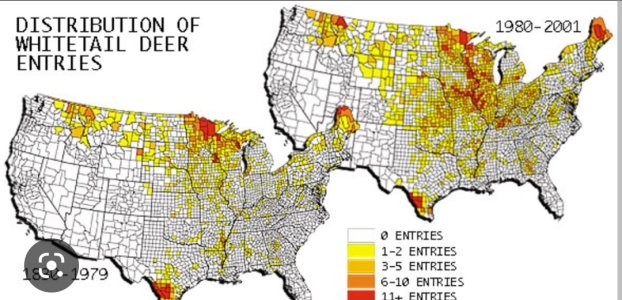Wind Gypsy
5 year old buck +
Takeaways from the recent MN DNR collaring study in SE MN were covered in the last issue of outdoor news:
Things that stuck out to me:
- Over half of the bucks stayed in their "birthplaces" (i'm not sure how they define birthplace, will look into that)
- I was surprised by average distance of dispersal, that's a long ways
- Didn't know does dispersed that much
From listening to the various results from Dr. Bronson Strickland and others, the health of pregnant does seems to have the largest impact on buck potential. Significantly more so than nutrition after birth. So it seems like in level of importance is Pregnant doe health > age > nutrition > genetics. For us folks with harsh winters, it seems like good thermal cover, food, and lack of predator/human caused stress through the winter would be the key to minimizing the decline of pregnant doe health. In wolf country I feel like setting up all of that is just asking them to be focused on by wolves throughout the winter..
- 26% of does and 43% of bucks moved away from their birthplaces to establish a new adult home range.
- On average, does moved about 12 miles from their birthplaces and bucks dispersed 14 miles away from their birthplaces.
- A few deer appeared to move back and forth between winter and summer home ranges.
- Deer that migrated between summer and winter ranges moved shorter distances; on average does and bucks moved 8 miles and 11 miles, respectively.
- Legal harvest and vehicle collisions were the main causes of death for young deer (1- to 3-year-olds) in our study.
Things that stuck out to me:
- Over half of the bucks stayed in their "birthplaces" (i'm not sure how they define birthplace, will look into that)
- I was surprised by average distance of dispersal, that's a long ways
- Didn't know does dispersed that much
From listening to the various results from Dr. Bronson Strickland and others, the health of pregnant does seems to have the largest impact on buck potential. Significantly more so than nutrition after birth. So it seems like in level of importance is Pregnant doe health > age > nutrition > genetics. For us folks with harsh winters, it seems like good thermal cover, food, and lack of predator/human caused stress through the winter would be the key to minimizing the decline of pregnant doe health. In wolf country I feel like setting up all of that is just asking them to be focused on by wolves throughout the winter..
Last edited:

